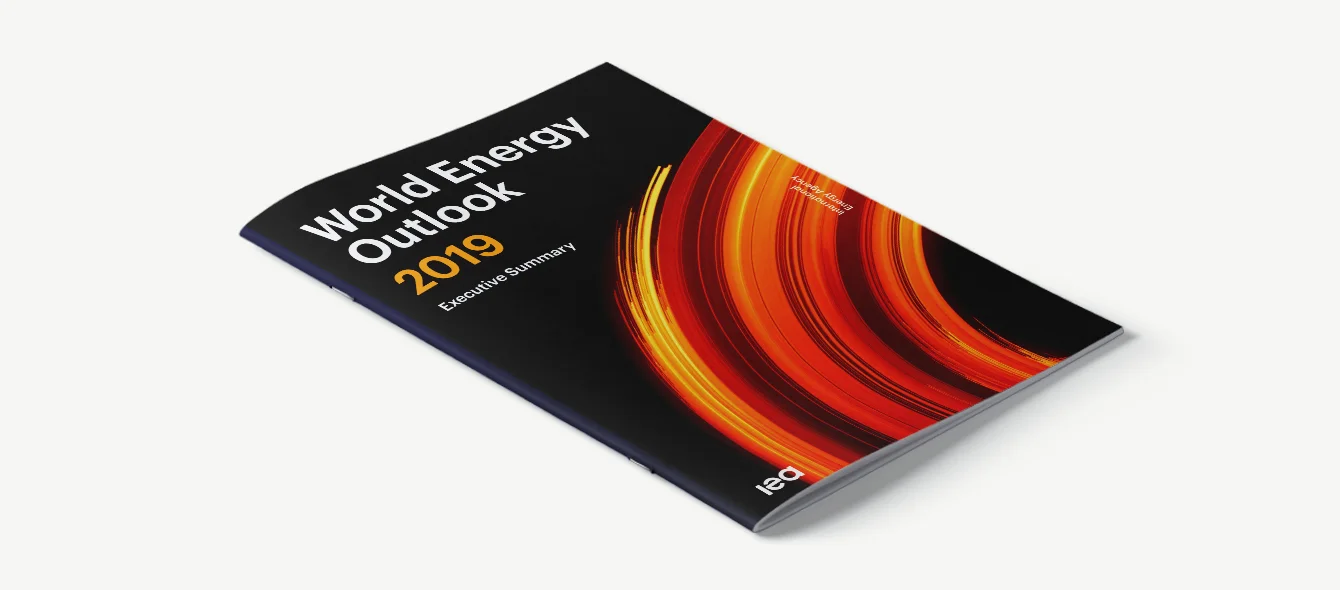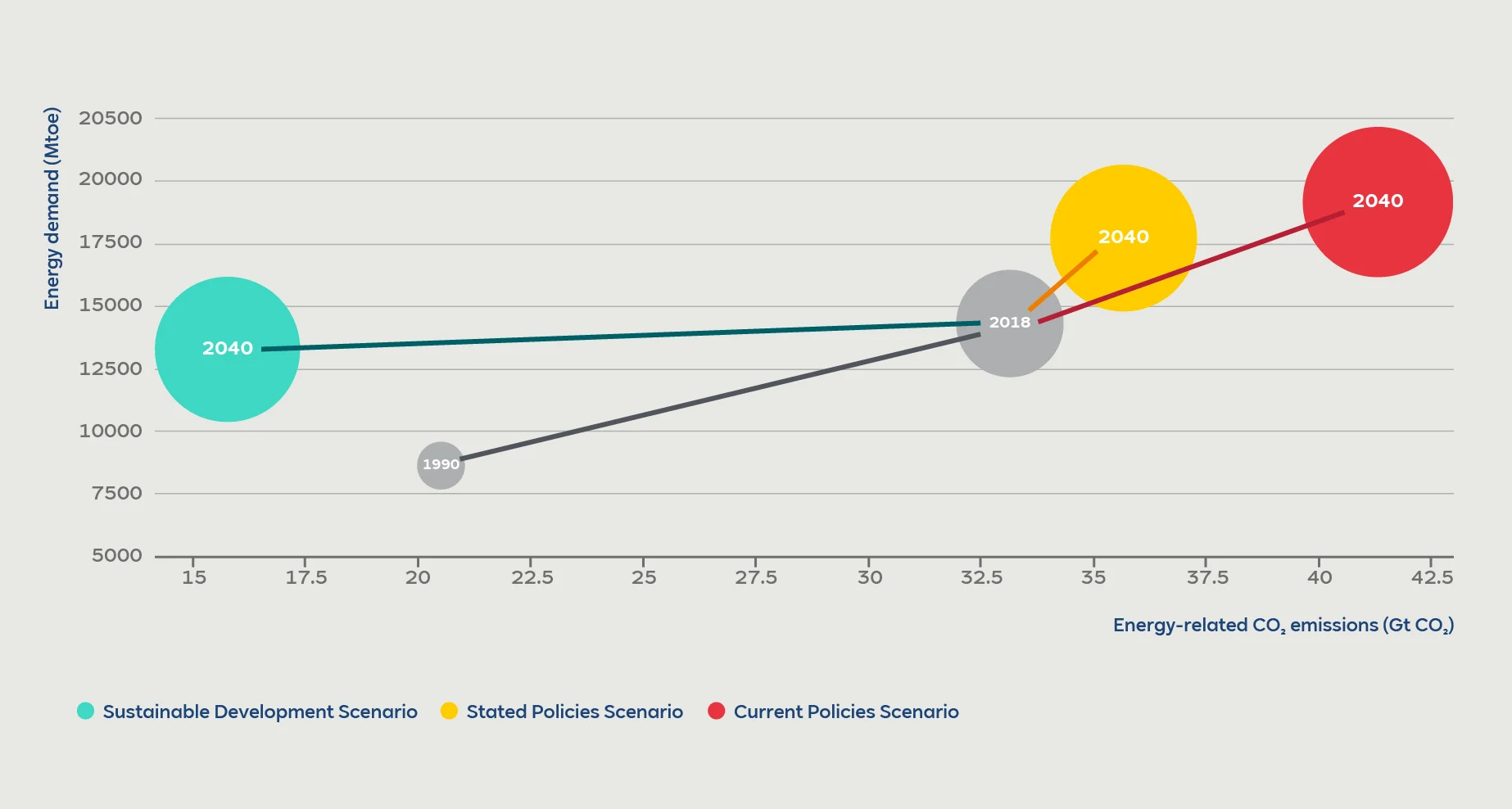The International Energy Agency (IEA) has published its World Energy Outlook 2019, an annual study forecasting energy demand out to 2040.
It comprises three scenarios – Current Policies, Stated Policies (previously called New Policies) and Sustainable Development.
- Current Policies describes the likely path of energy demand on the basis of policies already in place – in effect a business-as-usual scenario.
- Stated Policies forecasts likely outcomes if intended polices and targets already stated by government are successfully implemented.
- The Sustainable Development scenario is constructed differently. It starts with a sustainable future and works backwards to illustrate what needs to be done if that future is to be achieved.
This last scenario is aligned with the Paris Agreement on Climate Change’s aim to keep the rise in global temperatures to well below 2° Celsius above pre-industrial levels.
The gap between Current and Stated Policies on the one hand and the Sustainable Development scenario on the other in effect represents the challenge posed by climate change.
The IEA makes clear that neither the current policies of governments nor their stated policies currently put the world on a pathway to sustainable development.
Warnings
The IEA warns that the slowing rate of energy efficiency improvement – just 1.2% in 2018, about half the average rate since 2010 – is a major concern.
It says the pursuit of all economically viable opportunities for energy efficiency improvement can reduce global energy intensity – the amount of energy used per unit of economic activity – by more than 3% a year.
It also says falling battery costs will play a critical role in the energy transition, allowing the integration of storage into electricity systems increasingly dominated by renewable energy sources, and by providing cheaper electric vehicles.
In particular, the IEA warns of the growing popularity of SUVs, which it estimates could add an additional 2 million b/d of oil demand by 2040 on current trends.
No silver bullet
The IEA says all forms of energy efficiency, low carbon generation and carbon abatement are required to put the world on a sustainable energy path.
While solar PV is expected to be the fastest growing source of power generation, the agency makes special mention of offshore wind, which could meet the world’s electricity demand many times over.
In the Sustainable Development scenario, offshore wind provides as much generation as onshore wind in Europe by 2040, paving the way to full power sector decarbonisation in the region.
Total capacity of offshore wind farms in 2018 and forecast for 2040 in gigawatts
These forecasts are based on the Stated Policies Scenario. For the EU and China, these are compared with current figures (source: International Energy Agency IEA).The agency sees $1 trillion of investment in offshore wind by 2040 and says even higher deployment is possible if offshore wind becomes the foundation for hydrogen production.
But addressing legacy challenges will still be difficult. Energy demand growth is strongest in Asia, which has a huge and young fleet of coal-fired power plant.
To come into line with the Sustainable Development scenario, all coal plant worldwide needs to be retrofitted with Carbon Capture and Storage or biomass co-firing equipment, repurposed to provide system flexibility and used less, or retired early.
Government leadership
The IEA is unequivocal that governments need to take a lead role in fostering and supporting the technologies needed to reduce GHG emissions, stating:
“It is governments that set the conditions that determine energy innovation and investment. It is governments to whom the world looks for clear signals and unambiguous direction about the road ahead.”
Key numbers
Under Current Policies, global oil demand rises from 96.9 million b/d in 2018 to 121 million b/d by 2040, demand for natural gas increases from 3,952 billion cubic metres (Bcm) to 5,891 Bcm, and coal use continues to build from 5,458 million tons of coal equivalent (Mtce) to 6,399 Mtce.
Under Stated Policies, by 2040, oil demand rises much less to 106.4 million b/d, gas demand increases almost as fast as in the Stated Policies scenario, reflecting its role in displacing oil in transport and coal in power generation, to 5,404 Bcm, and coal use falls, but only slightly, to 5,398 Mtce.
There is a stark difference between these scenarios and Sustainable Development. Here global oil consumption falls rapidly to just 66.9 million b/d, gas demand drops to 3,854 Bcm and coal use declines precipitously to 2,101 Mtce.
Facilitating transition
To effect such a massive change and meet the world’s rising demand for energy, transformation must come from an increasingly decarbonised electricity sector.
Again, the numbers tell the story.
- Under Current Policies, global electricity generation rises from 26,603 TWh to 42,824 TWh, but power sector CO2 emissions jump from 13,818 million tons (Mt) to 16,594 Mt.
- Under Stated Policies, electricity generation increases to 41,373 TWh, but with only a very small increase in power sector GHG emissions to 13,834 Mt.
- Under Sustainable Development, electricity generation rises to 38,713 TWh, but power sector GHG emissions are cut drastically to 3,780 Mt.
Renewable energy sources, not including hydro power and bioenergy, need to meet almost one-third of power sector energy demand and 17% of primary energy demand by 2040 to ensure a sustainable future.
This compares with just 12% and 5% respectively under Current Policies and 16% and 7% under the Stated Policies scenario.
The inescapable conclusions are that the rate of renewable energy deployment must accelerate substantially and that the electricity sector becomes the pulsing heart of the energy transition, enabling the uptake of new technologies and playing a key and growing role in the secure supply of low carbon energy.
Photo credits: IEA

